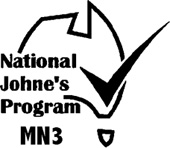Bundara Downs Animal Health
Bundara Downs has always maintained a high standard of animal health with the following accreditations;
- Ovine Johnes Disease Accreditation No.S8 MN3 ABC score 8 points
- Ovine Brucellosis Accreditation No. 997
- Stud/Selected sale rams DNA tested Hypotrichosis free
- Footrot free
- Lambplan member with Gold data status
- All Sale stock vaccinated with 6:1 with B12 and drenched with Cydectin SE.

Hypotrichosis - Use Bundara Downs White Suffolks stud with confidence
Bundara Downs takes its responsibilities as a producer of seedstock genetics for the prime lamb industry seriously.
Not only do we need to provide the industry with genetics that improve profit driving traits such as growth, efficiency, yield, muscling and fertility, we have a responsibility to ensure genetic conditions that could have a negative effect on productivity are identified, managed and eliminated.
When Hypotrichotis was identified as an issue in terminal breeds, Bundara Downs took the bold (and expensive) step of DNA testing all of our White Suffolk stud sheep resulting in a DNA tested Hypotrichosis free flock. Because Hypotrichosis is recognised as a simple autosomal recessive trait, meaning that both parents must carry the gene for it to be expressed in the progeny, using DNA tested free Bundara Downs rams or ewes means the problem will not appear in their progeny in your flock.
By the end of 2012, over 2000 Bundara Downs sheep will have been DNA sampled and tested, by far the largest and most comprehensive Hypotrichosis testing program in the breed. As a result Bundara Downs’ large input of DNA data into the Sheep Genetics Australia database, a GeneProb analysis is available for the entire Lambplan membership. This generates a carrier probability percentage for each individual animal.
What is Hypotrichosis?
The hairless condition, Hypotrichosis, is present in many mammalian species. From the literature relating to this condition, the indication is that in most cases it is a simple autosomal recessive trait, meaning that both parents must carry the recessive gene before there is any chance of it being expressed, and then the odds are one in four.
In sheep the condition has not been widely reported, however there is published evidence dating back to Popova-Wassina’s (1931) description of a ‘naked’ ram. In the Australian sheep population the condition was first identified by Dolling and Brooker (1966) and again by Mackie and McIntyre in 1992. In White Suffolks, the presence of the condition has recently been identified by a small number of stud breeder members. The gene was most likely introduced into the breed through appendix infusions of outside genetics in its development and improvement programs.
The ‘classical’ hypotrichosis phenotype in sheep exhibits a lack of fibres on the head and legs (and possibly the brisket and breech region) (Bawden, 2007). This mirrors the wool patterning phenotype, with the bareness being restricted to areas normally covered by shorter thicker hair fibres.
Observation of the skin from the bare areas shows a thickening of the epidermal layer, probably associated with an increased exposure to the elements. Microscopic examination of skin tissue by both Mackie and McIntyre (1992) and Bawden (2007) indicate an absence of fibres in the follicles, the degeneration of primary follicles into cyst-like structures, and the presence of cyst like structures associated with sebaceous glands.
In a terminal sire situation within commercial flocks Hypotrichosis is of little or no consequence, but in a breeding flock it requires some awareness and action. In addition, the AWSA Federal Council recognises that more White Suffolk cross lambs are being retained for breeding as prime lamb dams, so rather than ignore the problem, the White Suffolk breed has taken a proactive role.
The AWSA, through its Federal Council, is working closely with SARDI who have developed a DNA test which will identify sheep that carry this recessive gene. This means that AWSA members are able to test for the gene within their flocks, identifying its prevalence, and then move towards eliminating it from the breed.
References Bawden, C.S. (2007) Milestone report : AWI/MLA Sheep Genomics Project SG306 Dolling, C.H.S.,and Brooker, M.G. (1966) A viable hypotrichosis in Poll Dorset sheep J Hered 57 : 87 – 89 Mackie, J.T., and McIntyre,B., ( 1992) Congenital hypotrichosis in Poll Dorset sheep. Australian Veterinary Journal, Vol 69, No 6. Popova-Wassina, E.T., (1931) A Naked Lamb. J Hered 22 : 91 - 92
